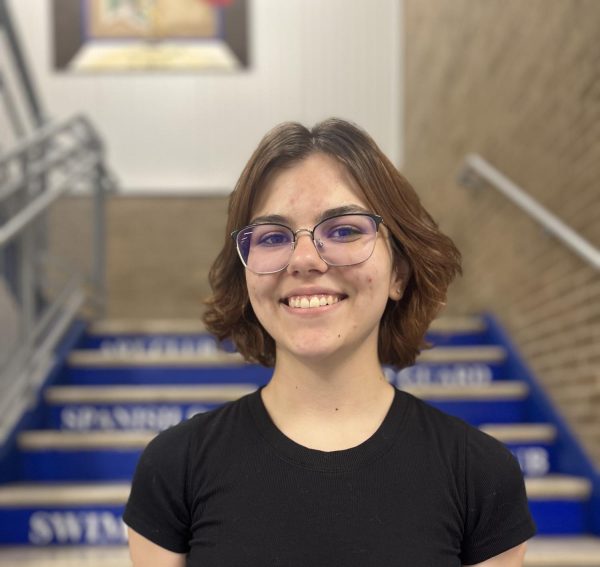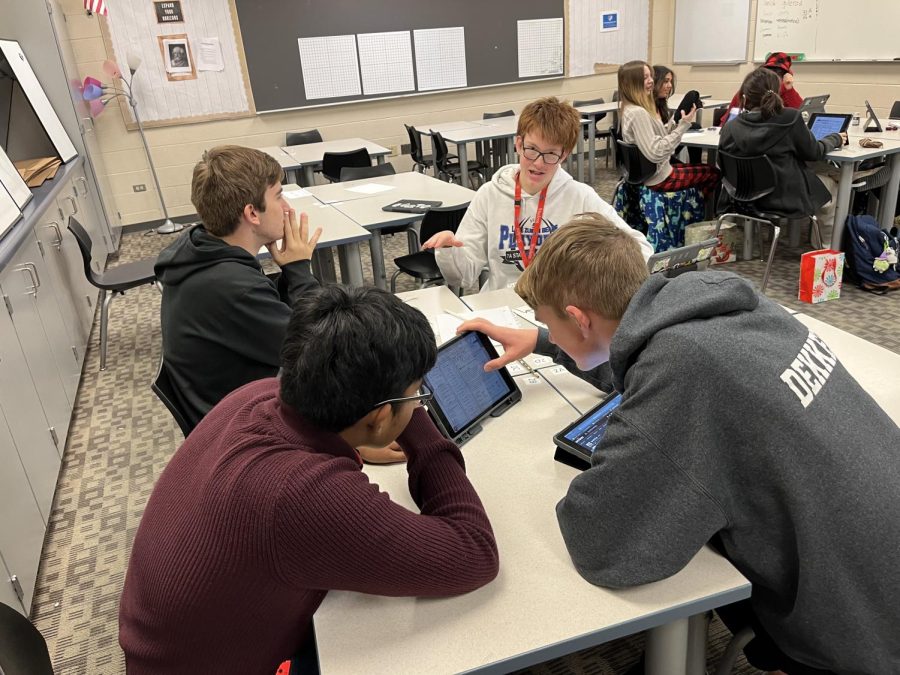Dungeons, dragons, and creativity
New Dungeons and Dragons Club open to all
Photo by Sadie Good
Matthew Homuth, freshman, runs a Dungeons and Dragons campaign at the after school club. Homuth shares the unique and creative experience of running a DND game.
Elves, gnomes, monsters, and magic; the 1977 game Dungeons and Dragons (D&D) has been a popular game among role-players and world-builders since its publication nearly fifty years ago. At LZHS, students gather after school on Fridays and submerge themselves in this personalized world through the Dungeons and Dragons Club.
D&D is a creative and strategic game that runs in “campaigns”, where players gather in groups of various sizes and role-play a collaborative story that can last anywhere from hours to years. These players have “a lot of creative liberty” with their characters and stories, according to Stephanie Ramirez, sophomore, who has been playing the game since her freshman year.
“[I really like the] fantasy aspect of the game,” Ramirez said. “You make up this whole story with your own characters and you get to go through with it [in your campaigns].”
For Ramirez, role-playing her own characters is both the best and most challenging part of the game.
“[Role-playing can be] kind of difficult. Sometimes it’s really hard to get into character, but [as the game progresses], it just becomes natural,” Ramirez said. “Right now, I have a character named Kevan, and he’s a wizard and a half elf from Germany.”
However, these characters are not the only part of the game; every campaign needs a ‘Dungeon Master’ (usually referred to as a DM) to form the bridge between the players and the world in order to allow the players to get creative within the DM’s guidelines. Matthew Homuth, freshman, has been DMing for about a year and a half.
“As a DM, I just try to figure out what sorts of things would be challenging for players, but not outright kill them,” Homuth said. “There are plenty of things that I could just throw in there that would kill [their characters], so I have to take into account all the different abilities and stuff and really just think about what the players want to do.”
Much like Ramirez, Homuth likes the “creative aspect” of the game and is happy to be a part of the “very supportive and positive community”. In fact, finding a community was how Homuth got into D&D in the first place.
“I started out by finding a small group of friends that were interested in it, and found that none of them had any clue what they were doing, and I had no clue what I was doing, so I just decided to give it a shot,” Homuth said.
Though Homuth started this way, in recent years, many new players have been drawn to the game by recent media such as ‘Stranger Things’, which revolves around a group of teens in the 1980’s who play the game. Although both Homuth and Ramirez think the increased interest in the game has been generally beneficial, they do believe that the media depictions of the game are inaccurate at times.
“I definitely think [the popularization] is beneficial towards the game as a whole, though a lot of the things are half accurate,” Homuth said. “They took popular names of monsters and named characters throughout D&D and changed them to fit their world, which I think is great for the show, but you’re not always going to have the ‘Evil Lord of the Upside Down’ in a random campaign.”
According to Ramirez, along with the scattered inaccuracies, the popularization of the game may have led to a change in perspective for some people when it comes to both the game and the community. People who previously saw D&D as a “loser’s game” think it’s “really cool” after seeing how the media now portrays it.
But according to Homuth, whether someone finds the game through popular media or through research, a spark of interest is all one needs to get into the game.
“Anybody can play,” Homuth said. “As long as you’re interested and are willing to learn and cooperate with people, you can play. Anyone interested in the club should give it a shot.”

As a senior, this is Sadie’s third year on the Bear Facts staff, and is excited to act as the Print Editor-In-Chief for the 2024-2025 school year. Though...

